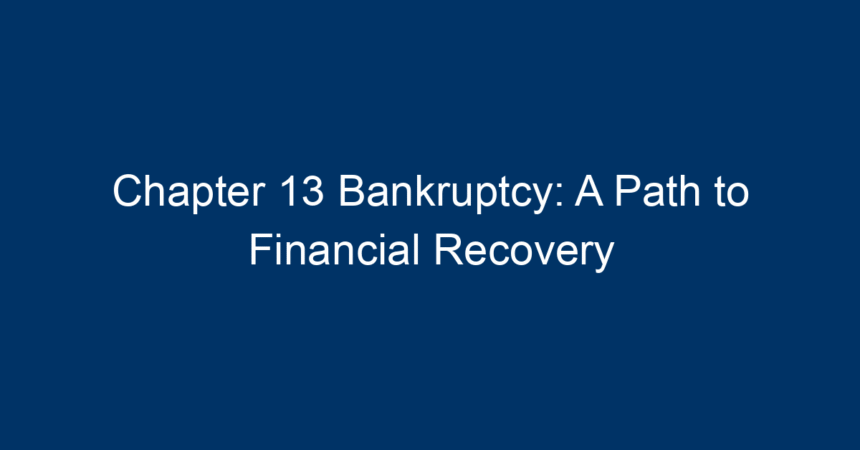In today’s fast-paced world, financial difficulties can arise unexpectedly, leaving individuals feeling overwhelmed and unsure of how to regain control of their lives. One option that many people overlook is Chapter 13 bankruptcy. This powerful tool not only allows individuals to manage their debts but also provides a structured path toward financial recovery. In this article, we will explore what Chapter 13 bankruptcy is, how it works, its benefits, and actionable insights for those who may be considering this option.
Understanding Chapter 13 Bankruptcy
What is Chapter 13 Bankruptcy?
Chapter 13 bankruptcy is part of the U.S. Bankruptcy Code designed for individuals and small businesses who have a regular income but are struggling with overwhelming debt. Unlike Chapter 7 bankruptcy, which liquidates assets to pay off debts, Chapter 13 focuses on restructuring. It allows debtors to propose a repayment plan to creditors over a period of three to five years.
Who Qualifies for Chapter 13 Bankruptcy?
To qualify for Chapter 13 bankruptcy, you must meet certain criteria:
- Regular Income: You must prove that you have a stable income source, whether it’s from a job, a business, or other means.
- Debt Limitations: Your unsecured debts must be less than $465,275, and secured debts must be less than $1,395,875 (as of 2023). These figures adjust periodically, so it’s crucial to check current limits.
- Credit Counseling: Before filing, you must complete a credit counseling course from an approved provider.
How Does Chapter 13 Bankruptcy Work?
Filing for Chapter 13 Bankruptcy
The first step in the Chapter 13 process is filing a petition in bankruptcy court. This involves submitting several forms detailing your financial situation, including assets, liabilities, income, and expenses. You’ll also need to propose a repayment plan outlining how you intend to pay your creditors over the next three to five years.
The Automatic Stay
Once your bankruptcy petition is filed, an automatic stay goes into effect. This legal protection halts most collection actions against you, including wage garnishments, foreclosure proceedings, and harassing phone calls from creditors. This gives you the breathing room needed to work on your repayment plan.
The Repayment Plan
Your repayment plan must outline how you will pay off your debts over the set period. The plan typically includes:
- Monthly Payments: You will make regular payments to a bankruptcy trustee, who then distributes the money to your creditors.
- Prioritization of Debts: Certain debts, like child support and taxes, often take precedence over credit card debt or personal loans.
The Plan Approval Process
Once you submit your plan, the bankruptcy court will schedule a confirmation hearing. During this hearing, the judge will evaluate your repayment plan, ensuring it meets legal requirements. If approved, you will begin making your payments as stipulated.
The Benefits of Chapter 13 Bankruptcy
Protects Your Assets
One of the most significant advantages of Chapter 13 bankruptcy is that it allows you to keep your assets, such as your home and car, while you work through your repayment plan. This is a crucial benefit for those worried about losing their property.
Restructures Debt Payments
Chapter 13 bankruptcy restructures your debts, making repayment manageable. By extending the payment period, you may find that your monthly expenses decrease significantly, allowing you to live more comfortably while paying off your obligations.
Stops Foreclosure
If you’re facing foreclosure on your home, Chapter 13 bankruptcy can provide immediate relief. The automatic stay prevents foreclosure proceedings while you reorganize your finances, allowing you a chance to catch up on missed payments.
Builds Credit Over Time
Contrary to popular belief, filing for Chapter 13 bankruptcy can sometimes improve your credit score. As you make consistent payments on your repayment plan, you demonstrate financial responsibility which can enhance your creditworthiness over time.
Common Misconceptions About Chapter 13 Bankruptcy
It Will Ruin My Credit Forever
While it’s true that filing for Chapter 13 bankruptcy will impact your credit score, it is not a permanent stain. The bankruptcy will remain on your credit report for seven years, but many individuals find their score improves once they start making consistent payments again.
It’s Too Complicated
The process can seem daunting, but it is manageable with the right guidance. Working with a knowledgeable bankruptcy attorney can help simplify the procedure, ensuring that you understand each step.
I’ll Lose Everything
In Chapter 13 bankruptcy, you can retain your assets. The process is designed to help you keep essential possessions while managing your debts efficiently.
Actionable Insights for Navigating Chapter 13 Bankruptcy
1. Assess Your Financial Situation
Before filing for Chapter 13 bankruptcy, take a comprehensive look at your financial situation. Make a list of all debts, income sources, and regular expenses to understand your financial landscape better.
2. Consult a Bankruptcy Attorney
Navigating Chapter 13 can be complex. A qualified bankruptcy attorney can guide you through the process, help you prepare your paperwork, and ensure your repayment plan is structured effectively.
3. Complete Financial Management Courses
Aside from the pre-filing credit counseling, consider enrolling in additional financial management courses to learn budgeting and money management skills. These skills can be invaluable in maintaining financial stability after bankruptcy.
4. Communicate with Creditors
Maintaining open communication with your creditors can prevent misunderstandings and might even lead to more favorable repayment terms. Being proactive shows your commitment to resolving your debts.
5. Stay Committed to Your Repayment Plan
Once your Chapter 13 plan is approved, it’s crucial to stick to it. Missing payments can lead to dismissal of your case, which would leave you back at square one. Make payments a priority to ensure financial recovery.
Conclusion
Chapter 13 bankruptcy can be a lifeline for those struggling with insurmountable debt. By allowing individuals to restructure their payments while protecting their assets, this process paves the way for a brighter financial future. If you find yourself overwhelmed by debt, consider this road to recovery. Remember, informed decisions are key to overcoming financial challenges. With the right planning and support, a debt-free future is within reach.
Final Thoughts
Acting decisively and responsibly is critical when considering Chapter 13 bankruptcy. Equip yourself with knowledge, reach out for professional help, and take control of your financial future. By following the steps outlined in this article, you can embark on the journey toward financial recovery with confidence.




